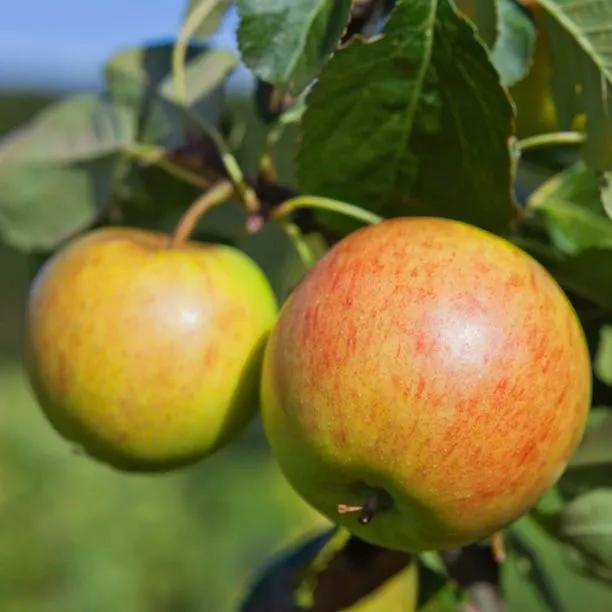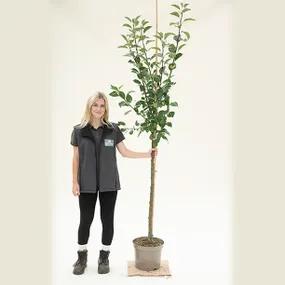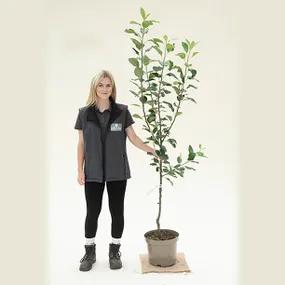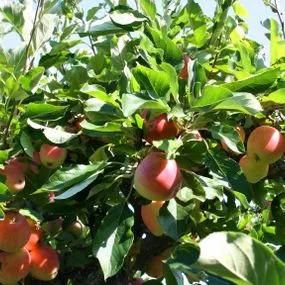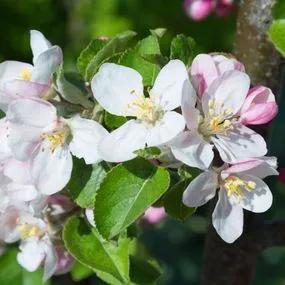James Grieve Apple Trees
Honest Delivery Prices- Height: to 2-4.5m
- Excellent multipurpose
- Spur bearer
- Self Fertile
- Pollination Group C
- Picking: September.
- Apple colour: green / red
- Recommended for the North and Scotland
- RHS Award of Garden Merit
Recommended extras
Description
Malus domestica James Grieve. Eating, Cooking
One of the best versatile apples, James Grieve was awarded his RHS AGM in 1993 for its handsome fruit and overall demeanour in the garden. The green fruit are large and attractively streaked with red, the cream flesh is very, very juicy.
Early in the season, the flavour is sharp and best for cooking, where they keep their shape in apple tarts or strudel. As the apple ages on the tree, it sweetens but always retains that slight edge to make it so wonderfully refreshing.
The texture is relatively soft, almost more like a firm pear.
Once picked in September, they will store for a month or two; early windfalls make marvellous juice.
The predominantly pink but quite discreet blossom is remarkably frost proof.
Browse our range of apple trees, or all our fruit trees.
Read our guide to buying apples.
Delivery season: Bareroot plants are delivered in late Autumn to Spring, about November-March inclusive. Pot grown plants, year round.
Features
- Possibly the best all round apple for eating, cooking, juicing!
- Spur bearer (good for cordons & espaliers)
- Self fertile
- Pollination Group C
- Picking: August onwards
- Apple colour: green / red
- Scab resistant
- Recommended for the North and Scotland
- RHS Award of Garden Merit
Growing James Grieve Apples
Apples like rich, well drained soil, and will thrive on clay in locations that do not get waterlogged in winter.
A full day of sun and shelter from the wind is ideal.
The blossom of apple trees coincides with the best of the bulbs; surround yours with Triumph tulips or lovely daffodils like Ice Follies.
Rootstocks:
We use MM106 for James Grieve, the UK standard for medium-sized trees, ideal for gardeners. It gives a half-standard about 4m tall, and a bush about 3m.
MM106 maidens are suitable for cordons and espaliers, but we use the less vigorous M9 for our ready-made cordons.
Disease Notes:
Resistant to scab.
Pollination Partners for James Grieve
Your trees are self fertile, making decent crops without a pollination partner, but still perform best with one.
James Grieve is in Pollination Group C, which cross-pollinates with other apple trees in Groups B, C and D.
Use our Fruit Pollination Checker to quickly find pollination partners, or Apple Pollination Guide to learn more.
Planting Instructions
Notes on planting apple trees:
All fruit trees like a rich soil with decent drainage, protection from the wind and plenty of sun. Apple trees like clay soil, as long as it is not prone to bad waterlogging.
Prepare your site before planting:
Improving the soil helps trees establish quickly and be productive for years. Preparing weeks or months in advance gives best results: fill the planting hole back up, don't leave it open to either dry out or fill with water.
- Destroy weeds and grass,
- Dig the soil over, remove stones, then mix in well rotted compost or manure down to the depth of about 2 spades, unless you are on heavy clay:
- On thick clay soil, only dig over the soil to break it up. Apply organic matter as a mulch over the soil after planting.
Spacing apple trees:
- Freestanding bushes: 15-18 feet (5-6m) between trees and rows.
- Freestanding half-standards: 18-30 feet (6-10m) between trees and rows.
In general, allow 1 more metre between rows than between trees along the row.
- Wire-trained cordons: 60-100cm apart along a row.
- Espaliers: 10-18 feet (3.5-6m) apart.
- Watch how to plant a fruit tree for a bush or half-standard.
- To grow a cordon or espalier, you need to install sturdy training wires.
Pruning apple trees:
- Maidens can be pruned in any style, including into bushes or half-standards.
- Bushes - start here when you buy a bush.
- Half-standards - start here when you buy a half-standard.
Accessories:
For bush and half standard apple trees, a tree planting pack, which includes a wooden support stake & rubber tie (a bamboo cane is enough support for a maiden), and a biodegradable mulch mat, with pegs, to preserve soil moisture stops and prevent weeds.
We strongly recommend using mycorrhizal "friendly fungi" on the roots of all transplanted trees.
Winter wash and grease are effective, organic pest prevention.
Did You Know?
Raised by James Grieve in Edinburgh, Scotland and introduced by his employers, Dickson's nurserymen, it was first recorded in 1893, received the RHS Award of Merit in 1897 and First Class Certificate in 1906, and its AGM in 1993.
For such a well known apple, no one is sure of his parentage, but he has been used extensively in breeding programmes, spawning the likes Katy, Lord Lambourne, Greensleeves and Elton Beauty, conferring on them its acidity and capacity to produce lots of juice.
Apple Tree Delivery Shapes:
Most of our fruit trees are delivered in up to 3 shapes (maiden, bush, and half standard), scroll up to see what's in stock.
Maiden: Unbranched tree, the most basic starting size, which you can train into the other forms (apart from mini patio trees).
Bush: Freestanding tree with a short trunk about 60cm tall. It will grow to about 3m. Ideal for small gardens.
Half-Standard: A freestanding form with a trunk about 120cm tall. It will grow into a full sized, "normal" apple tree, about 4m. Ideal for orchards, easy to mow underneath.
Cordon: James Grieve is a spur-bearer, suitable for cordons and espaliers.
Guide to Fruit Tree Sizing.

